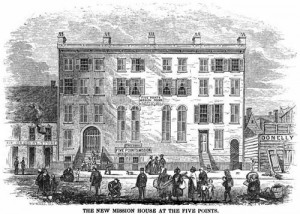Five Points Mission Records at Drew University
A great find I encountered in my Archives and Methods course was a collection of family records from the Five Points Mission (1845-1995). Â According to the General Commission on Archives and History, who manage the collection at Drew University, the Five Points Mission was organized in 1844 and was one of the first New York City-based missions established by American Methodists. Â The collection contains records on office administration, adoptions, baptisms, marriages, burials, and wills. Â
Our class was treated with the presentation of a small journal detailing the adoption of a young child as recorded by the biological mother. The mother expressed her concern for the child’s welfare — being able to feed, cloth, educate — in the face of spousal abandonment and poverty. Â
Much of this material (to the extent to which it is digitized) will help fill-out the information found in the Five Points Census Database that has already been introduced to teachers in our monthly seminars. Â
I’ll keep you posted on updates.
Â

From the book, "The Old Brewery, and the New Mission House at the Five Points" by Ladies of the Mission (New York: Stringer & Townsend,1854)
Last 5 posts by Donna Thompson Ray
- Photocentarian - August 11th, 2009
- Picturing U.S. History Blog: Images of Slavery as Visual Evidence - March 30th, 2009


